"Things you have to be convincing about"
"Ways to keep e-shoppers from ditching cart"
"Converting Traffic"
last updated 2017 Jan 12th

| If
you have a web site, and are selling a product or service on the Internet,
there are
"Things you have to be convincing about" "Ways to keep e-shoppers from ditching cart" "Converting Traffic" last updated 2017 Jan 12th |
 |
| 1. Warranty
service / Guarantee
2. Sizing, Price & Product Info 3. Functions and Features 4. Privacy 5. Long term use and upgradeability 6. Testimonials 7. Associations & Affiliations, Awards and Recognition 8. Shipping 9. After Sales Customer Service CLV |
10.
Corporate Citizenship: environmental considerations
11. Corporate Citizenship: social - cultural considerations 12. Corporate Citizenship: gender issues 13. Corporate Citizenship: human rights issues 14. Contact Information 15. Payment Security 16. Colours: use of 17. Shopping Cart abandonment issues 18. "engage" the customer |
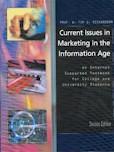 |
this unit is
in the text
"Current Issues in Marketing in the Information Age, 2nd. Edition" on page 49 - 62 |
| .. | This unit is
used in
o MGT D06 o MRK 610, MRK 619 o MRK 713 o BCS 555 o MGS 523 o CCT 322 o TCS 301 |
Not all of the material in this unit will be used in each of these courses; the amount of material covered will be indicated by the actual lecture given in class by the professor. Some courses cover this topic extensively, some courses deal with it briefly. |
 |
This web page has audio clips - just click on the icon (like the one to the left) and you can hear Prof. Richardson's voice adding additional information to topics on the page. |  |
turn on your speakers to hear audio clips |
| INTRODUCTION | , | This is a "unit"
prepared for the students of Prof. Richardson. It was first created
in 1999 for the simple reason that we looked for a list of "things to be
convincing about" and could not find one, so we made our own in class,
and every semester we have added on to it and further refined the entries.
|
| LEARNING OBJECTIVES | , | The purpose
of this unit is to give the reader/students knowledge of some specific
things to do in order to create (or amend) a website, and that these things
will encourage the online shopper to be "convinced" enough to actually
buy the product being offered.
The list is numbered, but that is only for instruction purposes - the numbers do not denote rank - none of these entries are more important than another entry. Many web sites already try to attend to several entries on the list - but if you attended to ALL of them, you would be more competitive. After reading this list, and then participating in the class discuss, the student should be able to apply these points to a web site and fit them to a real situation so that the site can be "more convincing". |
| KEY
POINTS for understanding this unit |
, | Many companies understand that to be successful one must be aware of the political environment and consequent regulations, social/cultural & labour considerations, national and international economic pressures, and technological developments but perhaps one of the most intense environments which effects companies in the new millennium is the competitive environment. The ramifications of the Competitive Environment cause marketing managers to be very diligent in making sure their message is “convincing” because the customers have so much choice and the competition is global. |
| . | , | Companies who
had a website “up and running” the past few years recognize that it is
not enough to have pages on the web, these pages need to be found and therefore
we have an increased awareness of the need to optimize your site so that
it can rank high in Search Engines.
But .... it’s not enough to rank high in a Search Engine - when people start scrolling through your pages, you have to be “convincing” in order to get them to buy - or, as they say in 2015, you have to "comvert" them
www.witiger.com/ecommerce/searchengineranking.htm |
 |
|
 |
In July 2004 "Things to be Convincing About..." was published in its full length of 3,500 words under the title "Creating a Successful E-Business" www.ecommercetimes.com/story/34966.html |
The
key is to look at several of these points and reflect on how your site
may be changed to be more competitive in that particular area. Sometimes
such changes are not a matter of just changing the words on the site, they
may require a corporate policy change - which would render some of these
points more time consuming to affect than others.
| 1. Warranty
service / Guarantee
2. Sizing, Price & Product Info 3. Functions and Features 4. Privacy 5. Long term use and upgradeability 6. Testimonials 7. Associations & Affiliations, Awards and Recognition 8. Shipping 9. After Sales Customer Service |
10.
Corporate Citizenship: environmental considerations
11. Corporate Citizenship: social - cultural considerations 12. Corporate Citizenship: gender issues 13. Corporate Citizenship: human rights issues 14. Contact Information 15. Payment Security 16. Colours: use of 17. Shopping Cart abandonment issues 18. "engage" the customer |
1. Warranty service / Guarantee
In an age of consumer skepticism,
describing your warranty service and return policy in detail, is one of
the marketing promotion activities that can be convincing. Detailed warranty
info may help convince the online browser that they can go ahead and buy
something, because, if there are any problems they can indeed take it back.
 |
Mountain Equipment Co-op has had a transactional e-commerce website operational since 2001 and considers it an extension of their successful older catalogue business. Karen Berrisford who manages MEC’s Mail order and E-commerce service says that they “try to keep barriers low and making returns easy. Berrisford explained that MEC began their remote sales with the philosophy that mail order purchases could be returned to any MEC store across Canada and extending this to their online customers has been natural. |
Peter ter Weeme, Senior Manager, Communications and Marketing for MEC says one of the messages they try to convey in the stores, and online, is that “not only do we guarantee the products we sell, we stand behind the advice we give. In the relatively anonymous world of on-line shopping, we believe this comprehensive guarantee gives members, who buy on-line, the confidence that they will get what they paid for.” For a company built on providing great advice to go along with their specialty hiking and climbing products, MEC has taken full advantage of the web to elaborate in great detail the ways in which a product can be used, and the appropriate product for each skill level of the user. Does it work? Berrisford explains “many members will purchase two or more of the same product in several sizes and return the items that don't fit - which is common for products like climbing shoes and hiking boots. These members appear to have have great confidence that the returns/refund policy is reliable and will work for them.” MEC’s website and catalogue sales are similar in size to one of their midsize stores and “web sales continue to have significant growth” says Berrisford which seems to validate MEC’s strategy.
For “pure plays” – web sites
that have no presence in a store, it is critical that the vendor create
some circumstance whereby a customer can easily return a product and that
this process be described in detail in the marketing promotional material.
E-commerce experts have suggested that companies with no “brick” store
might establish a relationship with a known retailer and arrange that customers
could drop off items there for warranty service, return or replacement;
however this advice may be harder to effect in reality, than in theory.
Presume that viewers of your
web pages are people that also looked at similar products on other sites.
It is important to describe your sizes, shape and colours in a way which
is precise so that viewers have no unanswered questions. Clothing size
measurements can't be simply small - medium – large, but rather small=34”
chest, medium=36” chest etc. and if you expect inquiries from other parts
of the world, then you have to use units of measurement that are globally
recognized.
| Medium and large sized companies have exploited the graphically capabilities of the web and high connection speeds to create “build sites” where a customer can mix parts and assemble modules and features online. Ford Canada’s Corporate Product Manager, Christine Hollander says their build and price site has been incredibly successful as an online tool which has driven sales at the dealerships. Hollander enthused that they “received more than 750,000 people a month doing a build & price on the site” and that “¾’s of all Canadians who purchased a Ford vehicle said they had been on the build & price site”. | “…more than
750,000 people a month doing a build & price on the site”
Ford.ca |
One of the obvious differences between putting assembly descriptions inside a cardboard box, and setting up assembly descriptions on a webpage is that the website will allow almost unlimited space to show images, exploded diagrams and pages and pages of detailed instructions.
Some companies also weave in comments from existing customers which show new users some innovative ways people have used the product beyond what may have been envisioned by the marketing promotions staff. This is particularly evident for consumer products such as cars and motorcycles that have a varied selection of aftermarket accessories.
One of the reasons why potential buyers find it convincing to see web pages describing detailed features is simply because many consumer products have complicated functions which are intimidating to new users.
Scott Bonikowsky, a divisional
vice president at Canadian Tire told Prof. Richardson that providing a
lot of information online about a product is great but that the consequence
is really deeper than one might expect. Bonikowsky explains that canadiantire.ca
has attracted a core group of users who spend time researching products
on their site and then go to the store to make their purchase. Quoting
a Gartner Group study of a couple of years ago, Bonikowsky says “we experience
approximately one dollar spent online translating into seven dollars from
customers who went and bought in a Canadian Tire store”.
| “The real magic” says canadiantire.ca V.P. Bonikowsky “is not only to obtain online sales but to get them to research online and then buy in the stores”. | As merchandising experts know, once the prospect is walking down the aisles, you then have the chance to cross-sell and up-sell to them employing various instore sales promotional techniques plus you have the added benefit of an informed customer browsing through items on the shelves which they researched online. “An informed customer is a good thing” concludes Bonikowsky “and our website certainly plays a role”. |
 |
During the 3rd week of March 2007, Richardson was interviewed by ecommercenews.org for a story about "click to call" technology. CTC technology offers eCommerce site visitors a chance to speak directly with a customer service agent through their computer. In discussing shopping cart abandonment, Richardson was quoted as saying "poor customer service or a mediocre client interface that isn't user-friendly is often one of the many reasons behind abandoned eCommerce shopping carts." see ecommercenews.org/e-commerce-news-010/0263-032707-ecommerce-news.html |
 |
eagleoptics.ca
sells binoculars and telescopes online. They have a great FAQ which explains
what the numbers mean in sizing binoculars.
http://store.yahoo.com/eagleopticscanada/binques.html Sometimes, authoritative info about the product can give the consumer confidence that the vendor really knows what they are talking about and can translate into a decision to purchase. |
“Virtually every major public interest survey over the last several years has shown that privacy is the No. 1 concern for people using the Internet” says the website of the Information and Privacy Commissioner of Ontario in its Review of Online Privacy Programs and Web Seals.
Privacy of information obtained in the payment process is part of payment security, but privacy can also be endangered in communications that have nothing to do with payment. Privacy also applies to making sure the customer knows you are not going to allow personal profile information to be released without consent. In 2004 there are national and regional governments passing laws to protect their citizens from Identity Theft and other crimes related to privacy circumstances
Chapters.Indigo.ca
devotes three pages on their website to explain their privacy policy, concluding
with the identification of a specific person, listing job title and contact
information, to deal with privacy inquiries. While Chapters does monitor
the posted privacy policies of their competitors, this is not of such a
concern as is making sure they are compliant with the Canadian government
regulations that will effect them. Most online vendors are making efforts
to be compliant with the PIPEDA, (informally referred to as Bill C6) by
taking steps such as posting privacy policies on their website and designating
a staff person with a title related to privacy issues. It is not clear
to some privacy officers Prof. Richardson spoke with how Bill C6 is expected
to be applied specifically, regardless, most online vendors are focusing
on somewhat more contentious issues such as payment security.
| Being able to handle privacy issues properly, and attend to new legal requirements, is not just a question of dealing with legislation but is also a competitive issue as many companies make privacy considerations a selling point related to building consumer confidence. | At the beginning of the dot.com boom, the Information and Privacy Commissioner of Ontario and the Office of the Federal Privacy Commissioner of Australia did a joint study on Web Seals and reviewed online privacy programs. The results of this study concluded that Web Seals had good potential to be an indicator of credible vendors due to the vetting process, but some time after the study was concluded, officials in the office of the Commissioner of Ontario noted that “these seals haven't taken off as expected and we are unsure about the degree to which they are being adopted”. |
TRUSTe, the first, and largest privacy seal on the internet, says that what keeps them going is the validation that customers are indeed looking for these symbols of credibility. “76% of consumers polled in a 2003 BizRate survey said that they look for a privacy statement or seal when shopping online.” Says TRUSTe’s Carolyn Hodge. Hodge adds that TRUSTe.com and market research firm NFO WorldGroup did a survey of consumers just before the 2003 holiday season and the results indicated that smaller e-tailers that do not post a privacy policy will lose sales.
Aabree Coffee Company of Oregon lists several Web Seals on their site at aabreecoffee.com. What appears convincing about Aabree’s list is that they take time to explain how difficult it is to obtain these credentials and specify the criteria under which a company may use them. If you told someone from another planet you had a black belt in karate it would mean nothing unless you explained the word karate was a name for a personal combat fighting form and that a belt coloured black indicated a high rank of several years training.
- see www.witiger.com/ecommerce/privacyissues.htm
For electronic products, such as digital cameras, notebooks, DVD recorders and GPS enabled cell phones, it is very convincing if you can explain, in detail, how upgrades can be obtained and installed / downloaded, and the cost. For physical products that come with parts, it can be convincing if you establish that parts will be available for a competitively long period. If you had a warehouse that stocked extra parts by the thousands, you could take a photo of the parts on the shelves and include it on your web site to validate your claim.
Sony
of Canada’s John Challinor explains that their popular VAIO PC
“can be upgraded and we stock parts and accessories to support that end,
fully communicating this information online as part of the process”. Challinor
noted that “some VAIO PC customers have viewed the ability of our products
to be upgraded as one important factor in their buying decision.
Challinor, the General Manager of Advertising, says SONY “recently initiated
an online build-to-order program for the VAIO PC, which is enabling our
customers to build and order a solution that not only meets their near-term
requirements, but their longer term needs, as well.” Challinor emphasized
that the warranty and ability to upgrade “are- an important
and differentiating fact that we also communicate to our customers online."
| 2000Watches.com
is an aggressive and energetic vendor which does a thriving business
selling wrist watches online. Having built a very long list of testimonials
from satisfied customers, head office based in Kuala Lumpur says "testimonials
are certainly an important tool in e-commerce enterprise. Numerous times
our customers have indicated that the testimonials are the driving factor
in choosing to purchase”. 2000Watches testimonials list is indeed very
long and they enjoy building the list with unsolicited contributions “all
the testimonials are unsolicited, they arrive from our customers after
they've received the watches."
www.2000watches.com/vshop/testimonials.html Bob Davis, who runs mywatchmaker.net, says testimonials can be convincing, but you also have to be aware of privacy issues.  |
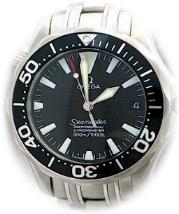 |
Testimonials are also used in G2B situations where the government wants to convince businesses of the merits of a particular program. In the case of the Dept. of Foreign Affairs and their highly publicized Team Canada missions, DFAIT devote considerable space on their website to profiling companies that participated in past missions and provides a lengthy testimonial from the participating firm see http://www.tcm-mec.gc.ca/success/new/prospectus-en.asp. What is convincing about Prospectus providing the testimonial on the DFAIT site is the words of the specific Prospectus executive quoted, and the direct link to the prospectus.com page.
Click on the rifle to see
a long list of testimonials from an American firearms manufacturer's website
- the list include peoples names, locations, and often photos of them holding
the rifle!

| Update 2007
Feb 22
When we were discussing Testimonials in class (FSM 620) 2007 Feb 22, it was explained that sometimes such simple information, such as a person's proper first name, and last name, and the name of their small town, could put them in a vulnerable situation because it would then allow someone to look up more information about this "rifle owner" who was listed in the tesimonials - with the obvious consequences for privacy vulnerability. So, one of our students (Mike C.) decided to take up the challenge of seeing if it was indeed possible to track down such information, and... before the class was half-over, Mike had found detailed personal profile information of one of the women who was listed as a rifle owner, on the Henry site. Mike's comments and narrative are available by clicking on the screen capture to the right. |
| Testimonials
- effective Tactics |
|
| Zainab's comments are in the context of a problem we noted in class Sept 17th (2009) that being: if you provide more detail on the ID of a person giving a testimonial (in order to appear authentic) you may put that person at risk. Zainab explains "If Company X, in attempts to protect its customers’ identities and respect their privacy, chooses not to display the name of the customers who provide testimonials, it might be accused of writing its own testimonials (fake publicity). In fact, in some cases, this accusation might even be accurate." |
| Testimonials
tactical alternatives |
Zainab suggests "The internet is home to numerous forums that attract diverse communities of interest. Members of these forums voluntarily provide their information to the forum administrator in order to register. This registration process is distinct from and not directly connected to Company X. Forum users use these forums to discuss various topics, brands, manufacturers, suppliers, companies, etc. and provide each other with reviews (both good and bad) on the performance of a product/service they purchased. It is up to Company X to seek out good reviews on reliable and active forums, and insert their links on its website. This allows viewers to get first hand/real-time feedback of the product/service they are interested in purchasing." |
| Testimonials
Strengths
|
Zainab explains
1) Any personal information provided by the forum user to register is completely separate from and unrelated to Company X. This takes the responsibility of privacy protection off of Company X. 2) Because the forums are separate from Company X’s website, viewers might perceive them to provide more realistic reviews on Company X. This is opposed to advertisements or testimonials on Company X’s website declaring how wonderful and innovative the company is. |
| Testimonials
Weaknesses
|
Zainab offers
In the consideration of creating links to forums "Viewers may not click on the links that lead them to the active forums" "Forum users who provide bad reviews might negatively influence a potential customer" |
| Testimonials and Humour | When
browsing around the Web, one should keep in mind that it is not entirely
representative of the conservative straight-laced business world. The Web
was originally built by young professors and grad students in the mid to
late 1990's, who had, at times, a very humourous and sarcastic approach
to their creations, hence corporate names such as Yahoo. So when you are
thinking about Testimonials, for some types of products, it would not
be inappropriate to inject a bit of humour.
WTGR |
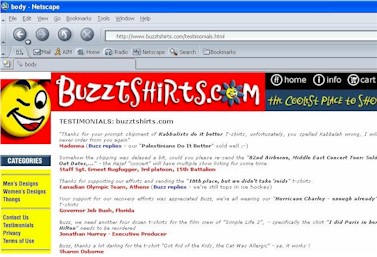 |
Tim
Richardson was the person who wrote the testimonials for the online T-shirt
retailer www.buzztshirts.com in 2004
(the domain is no longer active in 2009) Some of the testimonials he created are rather amusing - and the point is to cause the reader to think they are very funny, and maybe forward the link to other people, which would spread word about the company's website, and hopefully the extra exposure would help them sell more T-shirts. |
Got my shirt Buzz, "Alimony: A System Whereby Two People Make a Mistake and One of Them Continues to Pay for It", by the way, you charged me too much for shipping, you're fired Donald Trump
"My guy and I split up Over Religious Differences – He Thought He Was God and I Didn't" was supposed to be send out as follows, 1 large for P. Diddy, 1 size medium for Ben Affleck, another medium for Cris Judd J. Lopez
"I'm
on a 30-Day Diet. So Far I've Lost 15 Days" - uh, are you sure Buzz
this is how it goes? Oh, and please send me the 2XL, cancel the 1XL
Oprah
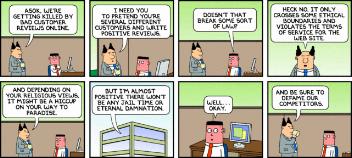 |
A funny Dilbert cartoon about faking online reviews and testimonials which was posted by former student Bilal Jaffery on the Facebook group for former students of witiger, Jan 17th 2013. |
Membership in a recognized
industry association, and the appearance of the association's logo on your
web page, can be convincing to viewers that may have never heard of your
company. Being a member of an identifiable association can add legitimacy
since confirmation of your membership can be checked, and this contributes
to validating your business. Association membership may also include the
benefit of participating in conferences and trade shows, and it may also
be an opportunity to profile your company executives through their involvement
in any events. Battersea Pen in the U.K. specialize in selling, and refurbishing,
high quality vintage fountain pens and pencils. On their website www.penhome.co.uk
Battersea Pen note that one of their founding partners was “elected to
the Board of Director of the Pen Collectors of America”. Battersea further
note that they “organise the London Pen Show which is held annually in
October and is the largest pen show in the world outside the USA.”
| Affiliations with industry accepted standards can be convincing to potential customers who query if the product meets requirements they have for a particular use. | These affiliations may include being certified as a providing a certain level of service. Navantis.com, a Toronto based e-commerce and IT professional services firm, prominently displays the Microsoft Gold Certified Partner logo on their main page. Michelle McLay, V.P. Marketing for Navantis, explains that “the logo enables visitors to immediately make an association with one of the world’s leading software brands. It establishes a sense of trust and credibility with visitors who may not have heard of Navantis before”. McLay added “the affiliation with Microsoft also offers Navantis a substantial endorsement given the considerable barriers to entry in this competitive market segment”. |
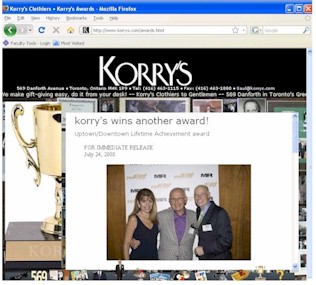 |
An example of using awards
on a site
Danforth Gentlemen's Clothier store Korry's, www.korrys.com has an engaging website that includes a section for awards that they have received. Part of being "convincing" on the Korry's site is the fact that they keep the awards page updated so it appears as if Korry's is always winning awards (which is true). |
Companies that sell a product
or service, which is subject to industry or association awards, can make
a spot on their website to identify the awards won, particularly if these
awards are well known. Archibald Orchards & Estate Winery www.archibalds-estatewinery.on.ca
near Bowmanville has a modest website on which they describe the product,
location and events typical of a seasonal vendor. Proud to list their Gold
Medal for “Canadian Maple” at the National Fruit Wineries of Canada Competition,
Sandy Archibald told CB “I have had a number of people comment on the awards
listed on the website. It is definitely perceived as credibility to many”.
| video to come | Screen capture video showing the affiliations listed on the Navantis.com site |
Of the 4Ps (Product, Price, Promotion, Place/Distribution) it is the last one, Distribution, that often seems to be the weak link in customer satisfaction as dot.com companies gear up to ship out product to customers that ordered. One of the things that is convincing is if you can explain in more detail (than the competition) how the product will be wrapped, packaged and sent - especially if you can describe each stage in the process with words that indicate care and consideration for maintaining the product in good condition.
Some companies have spent considerable money to identify the actual location of a shipped product even if it is in mid-transit: this is possible now that the GPS technology, widely used in ocean shipping, truck shipping and rail shipping, has applications developed for smaller companies. As the technological environment develops more and more ways of tracking cargo containers (as the pressure of the economic and competitive environment dictates these developments) it will be possible to have better and better information on the precise location of shipped items and communicating this on your website can be very convincing.
The majority of medium and small sized e-commerce vendors do not ship their products direct to customers but rather use the services of a large firm like FedEx, UPS, etc. Any problems challenging these big shipping companies become your problems if the customer doesn't receive the product on time, or packaged in the condition they expected. Gary Wright, Logistics Supervisor for Markham based ATI Technologies www.ati.com , told CB that online vendors need to be very careful about the exact delivery techniques that shipping service companies offer. Wright explained that “companies like ATI can be hit for a lot of problems if the shipping company leaves the package at an address and walks away” (if no one comes to the door), whereas other companies might have a policy of leaving packages only if a person signs for it. Wright added that one of the things to ensure that your customers are convinced of your reliability for shipping is to “make sure you do not boast on the site about delivery times that cannot be met”. The ATI site is quite detailed in describing the circumstances of how the items will be shipped and what limitations there might be, and they appear to be convincing in these explanations since Wright noted customers have responded positively.
A couple of years ago the U.S. Federal Trade Commission went so far as to warn specific online vendors that they better stop breaking promises about shipping times or they might be charged. The charges stemmed from the fact that some of the large online vendors of seasonal gifts had not sent out notices informing customers that shipments wouldn't arrive as promised – which would violate several regulations about making certain service claims in marketing material.
Some companies have seen
the challenges of shipping as an opportunity to clinch customer satisfaction
and make this a selling point for repeat business. These companies use
different techniques such as follow-up emails, or phone calls or postcards
to ask customers to indicate if the package did arrive on time, was it
wrapped securely, etc. By showing the customer that they cared how the
goods arrived, these companies have enjoyed growing their business by having
a higher than average growth in repeat customers.
After Sales Customer Service is part of creating CLV, Customer Lifetime Value (see witiger.com/marketing/CLVandVelvetRopeCustomers.htm) and goes towards convincing the customer that they should make repeat purchases. Developing a strong program of After Sales Customer Service should be initiated by the e-tailer because you don't know why a customer continues buying, or stops buying unless you ask. In a brick and mortar store customers may walk in and you can chat with them to ask why they responded a certain way to some thing you did, but in the online world this does not happen so easily - it is very rare that someone will email an online vendor to say why they no longer visit the site.

Richardson discussinng Cognitive Dissonance |
A significant
part of developing After Sales Customer Service is dealing with a concept
that marketing experts refer to as Cognitive Dissonance. Nalini
Mohan of University of Texas at Austin says "Dissonance arises from the
discrepancy between the cognition "I am complete, self fulfilled individual"
and the new cognition that the product or lifestyle portrayed is lacking."
uts.cc.utexas.edu/~nalini/CognitiveDissonanceIntro.html
https://www.youtube.com
|
“After-sales customer service
for women is important” said Ford’s Hollander and an example of what Ford
does is their carsmarts seminars which can be booked online for the sessions
held at dealerships across Canada.
| “... in order to be able to communicate such information on our website, the internal reality must back up the external messaging. It is the philosophy and practice of The Body Shop that to be competitive & successful and attract customers and develop their loyalty, corporations have to be able to communicate about, and prove their willingness to include, environmental and ethical considerations…” | Some complain
that corporate considerations of the environment are not as high a ranking
factor as one might hope for in a globalized economy stressed by the competitive
environment. However, there are a number of e-commerce examples of how
explicit descriptions of environmental concerns can contribute to customer
loyalty among some consumer segments and also serve to deflect criticism.
The Bodyshop, which has strategically profiled environmental considerations
as part of building their brand has an extensive section on their site,
thebodyshop.ca, which discusses
their commitment, their actions and how their customers can help under
the heading “Profit With Principles” .
Rifka Khalilieh, Values Facilitator
at The Body Shop, explains that the reason the firm went to such lengths
to discuss their environmental attentiveness on their website is
because their customers demand it. “Trust is an increasingly important
brand quality and consumer value” explains Khalilieh and “by communicating
to the customer what we believe, what we do, and how customers can help,
we build a sense of trust and transparency that builds consumer loyalty.
|
| With the advent of chat rooms and web blogs, people like to "champion" good and bad causes and it is wise to avoid being cited in many online places as being a company that pollutes, or uses toxic materials in packaging, etc. As for deflecting criticism, McDonalds has long borne the brunt of many activists and has responded in part by establishing a very lengthy description on their website about their policies to reduce, reuse and recycle. Ron Christianson, Manager, Corporate Communications of McDonalds Canada says they go to some length to describe an “Environment Rainforest Preservation Policy” on their Canadian webpage. | “.. it is important
for companies to be more transparent in the way they conduct their business
and a website is very useful to use in that respect …”.
McDonald’s |
Dot.com companies are vulnerable just as much as traditional brick and mortar companies are to situations where customer groups or employees are discriminated against. Since dot.coms operate in a global environment (whether they like it or not) they must hold themselves to the highest standard of citizenship which can be challenging in situations where the company is located in regions of great cultural diversity or ethnic and religious controversy.
Alan Vernon, Managing Editor
of toronto.com
says : " It is a challenge to handle the diverse range of the thousands
of topics and events that are profiled on our site". But Vernon adds
that "over time you get a feel for all the different cultural
communities and you develop contacts that help to ensure the credibility
of each submission". Vernon explains that it is not only accuracy
that's critical when providing this kind of community exposure online.
Equally important, he says, "is sensitivity when publishing these cultural
events, both from the perspective of the event participants
and our users as a whole." Bottom line for us is to maintain
a site that people consider authentic, up-to-date and truly
useable.
aa
| This is what happens when you try to be politically correct by having all sorts of ethnicity's in your marketing pics, then someone gets cute and tries to tweak it country by country. |
| video to come | So when WTGR was showing this pic of Microsoft's mistake re: Poland in the BCS555 class Sept 29th 2010, student Shawn B. (w Peter S. holding the camera) made some comments about additional inconsistencies with the imagery in this photo - whiuch you find humourous and interesting to hear about. |
see www.barfingunicorn.com/?p=206
for some crazy examples of what could have been done
In a BizRate.com Online Research Value Panel in September 2003, results showed that 62% of online buyers were women. Online shoppers are a much different "demographic" from the period of 1997-2001 and if a vendor ignores the growing numbers of women online then they will not be very credible in their marketing, let alone convincing.
Ford’s Christine Hollander says that “86% of all vehicle purchases are influenced by women” which has been one of several factors driving the choice of content and features on Ford’s website. Hollander explained that Ford recognizes that “women do a lot of research online, and among their friends and associates” before making a purchase decision. Anil Chopra, General Manager of one of the leading Ford dealerships in Toronto, told CB “women walk on to the lot holding the a build & price pages in their hands”. Having customers who are pre-informed of many of the vehicle's features makes some parts of the salesperson's job much easier said Chopra.
In terms of addressing gender
issues on a corporate site, there are a number of examples from across
the spectrum of vendors. Ford.ca profiles their support for the Canadian
Breast Cancer Foundation with the Pink Ribbon campaign featured on
the main site during October each year. Hollander said the partnership
with the CBCF has proved fruitful in many ways and the exposure on the
website has allowed Ford to show they are involved to a significant degree.
Human Rights Activists are often involved in letter writing campaigns. If your online company wanted to champion a cause in a stressed region you could use part of your web page to explain about a particular cause, and invite people to contribute comments. For example, a Martial Arts School could have a note on their web site saying they promote a particular Women's Shelter and advocate writing letters to a particular government official to obtain more funding for services related to that shelter. If you want to appear very determined in your support of Human Rights issues you can have a link on your site to The Office of the United Nations High Commissioner for Human Rights and note specific things that you follow to be in compliance with established practices that such NGOs evangelize about it. The UN's Universal Declaration of Human Rights is at www.un.org/Overview/rights.html and is free to be copied and forwarded to people throughout the globe.
Companies that operate businesses
in the clothing sector have been challenged to substantiate that their
product is produced by suppliers in a way which meets the human rights
considerations of their enlightened customers. The Hudson's Bay Company
dealt with the issue some years ago by establishing a Code of Vendor Conduct,
which is now explained in great detail on their site at www.hbc.ca.
Bay's Rob Moore, V.P. Corporate Communications of HBC, says “we use the
site to move beyond the PR rhetoric and offer a chance to see the detailed
policies behind public statements, for example explaining that the Vendor
Conduct code is backed by an independent compliance and monitoring program”.
Moore acknowledged that companies are challenged these days to “meet the
demands for increased disclosure for public companies and our website helps
in this regard”. “You have to be able to back up what you say” says Moore
"and this section on our website helps to be convincing".
Many corporate web pages are conspicuous for the absence of specific contact information for "real people". It is very disconcerting to not be able to find the real name of a real employee with a specific job title when you wish to communicate with someone in the company.
Gordon Whyte, About.com's e-commerce expert says "Don't Appear anonymous. Customers will feel more comfortable placing an order with you if they feel they know you”. Contact details on a site are essential. “If you can put names and faces along with them, it's even better” says Whyte. An "About Us" page with the history of the company, corporate goals, and media contacts all adds to customer confidence.
Publisher Rod Morris of Style Magazine style.ca, the Canadian fashion publication, agrees that having the names of all their editors, writers and other senior staff on their contact page has been helpful in obtaining membership, advertising and story leads. The specific arrangement of information on the contact page should be done so that it can be easily printed out on to 8.5” x 11” paper since that is what most people do before making calls – they print the page, then write on it while talking to you.
Sometimes companies deliberately avoid putting detailed contact information on the site because they want to channel everybody through sales and customer service – presuming that 99% of the inquiries will be customer service problems. One of the fundamental consequences of an online circumstance is the understanding that being online means everybody in the company with email is potentially empowered to deal with contact with the public.
A significant part of contact
information is validation that you do exist. Many people find it comforting
to know that there is a physical store, even if they never have a chance
to visit. There. Having an image of your store on the splash page, is also
quite convincing, especially to older shoppers. Some stores go further
and shop pictures of the staff lined up in front of the product laden shelves.
| - something smaller companies
have to try extra hard to deal with in order to provide a secure situation
and convince buyers that they won't be scammed
- read Chet Dembeck's October 1999 article /people.senecac.on.ca/tim.richardson/articles/creditcardsecurity.htm in the www.ecommercetimes.com - it was a problem back in 1999 and is still a problem in 2002, 2003 and 2004 - see also our credit card page www.witiger.com/ecommerce/creditcard.htm - and our e-payment systems page www.witiger.com/ecommerce/paymentmatrix.htm |
 |
student Magda C. sent an
email in early April 2006, regarding the use of particular colours on web
sites.
Magda said, Hello
Sir!
|
| Magda explains For
example, "Saturated colors: Saturated colors are pure and strong. They
have the feel of coming straight out of the tube and consequently lack
sophistication. Avoid them at all costs, they will speak of cheap, uncreative
amateur attempts to "bludgeon" visual relief into pages. They are very
tiring to the eye and look dreadful when combined or used on large areas
(heaven forbid). Huge bevelled buttons are a favourite area of travesty
for online saturated crime." There are other links too that evaluate different
aspects on your website. I thought that this site would be verrrrrrry interesting
to anyone who is doing an on-line business because it can really help in
creating the right attributes that you are looking for in your branding
image.
As you mentioned in class there are different ways to market something, for example, selling something to consumers because they think they will be saving money or because it is cheap. Well, according to this website, you want to then use colours that help you carry out this message, and go for a colour like yellow for example. COOL eh? |
The site Magda was talking
about is
http://www.web-design-uk.biz/web_design/psychology_color_marketing.htm
Student Cindy Wai-Chung F.
emailed in Feb 2009 to say
"the
link about "use of color", provided by your student, Magda C., in 2006
does not work anymore. I suggest this link
http://www.garrettmedia.com/mission/gdes81/color_psychology.gif
since
it outlines the Do and Don'ts of color usage in different countries.
It
is important for companies to understand the meaning of different colors
worldwide, as their websites will be viewed globally."
| Arellano's interview of Prof. Richardson was for a story about online shoppers clicking through the "shopping cart" on websites, then abandoning the checkout without buying. Tim explained that sometimes this is not a bad thing - in fact many times online shoppers are simply looking at the detailed description of the product as described in the shopping cart, and then they go into the store and buy the product. In the interview with itWorld it was added that sometimes it is more desirable to encourage the shopper to go in to the store because then you can hit them with in-store promotions and cross-sell them or up-sell them on other products they see in-person (as Canadian Tire's V.P.Bonikowsky says at the beginning of this section). |
| Preventing
Shopping Cart Abandonment |
the following
text is from the itWorldCanada.com article that quotes Prof. Richardson
"Too often online shoppers get cold feet just at the point of concluding a sale," said Thomas Harpointner, CEO of AIS Media Inc. of Atlanta. He said a recent survey of 1,100 online retailers in North America indicate that nearly 60 per cent of online shopping carts are dumped by customers before a purchase is ever made. What are the main reasons for shopping cart abandonment? "We found out shoppers were either frustrated by a slow site or weren't confident with the retailer," said Harpointner. A Canadian-based e-commerce expert ascribes the problem to poor customer service in online stores as opposed to bricks-and-mortar outfits. Some online retailers simply forget customer service still applies on the Internet, noted Tim Richardson, professor of e-commerce, marketing and international business at Seneca College and the University of Toronto. "Some e-commerce software focus so much on getting people to buy that they end up irking the customer instead." It could be too late to do some dramatic Web site changes for this holiday season, but here are a few suggestions from Harpointner and Richardson on how to prevent shopping cart abandonment for next year. Feed the need for speed Pick a host site and e-commerce software that can handle your traffic. Some retailers spend a vast amount of money in marketing and other areas of their business, but scrimp on their budget when it comes to choosing a Web host and e-commerce system, says Harpointner. |
| Preventing
Shopping Cart Abandonment |
Check out
the competition
Before settling for an e-commerce software product, ask to check it out. Better yet, check out how it's performing at a competitor's site.Answer known-unknown Provide adequate product information on your Web site. Richardson said this worked wonders for Canadian Tire Corp. The retailer has attracted a core group of customers who spend time researching products on the company's site, canadiantire.ca, and then go to a store to make their purchases.Privacy and security Identity theft and online fraud [see witiger.com/ecommerce/identitytheft.htm ] is a major concern for almost anyone on a computer. You can mitigate customer's fears by employing adequate security features and limiting request for personal information to just what is needed. A few strategically placed messages and links to your privacy and security policies can never hurt. |
| Preventing
Shopping Cart Abandonment |
Cash, credit
or bottle caps
Provide payment alternatives. [see witiger.com/ecommerce/paymentmatrix.htm] Empowering the customer to choose on a method of payment can increase your market coverage by five to 15 per cent according to Harpointner.The price is right Everyone loves a sale. Emphasize price savings, offer coupons and special deals.Return to sender One reason people are wary about online shopping is because they don't want to be stuck with a product they don't like. Offer a clear, fair and reasonable return policy. Make this information easily visible to the buyer. |
| Preventing
Shopping Cart Abandonment |
Provide human
contact
Some retailers believe the Internet provides them refuge from the public. Although, they're buying online, shoppers still appreciate the human touch. Make 1-800 contact numbers easily visible and strategically located in areas of the site where they might be needed. Dell Canada Inc. in North York offers an innovative take on this idea. The computer firm's site has a chat feature that enables customers to engage in instant messaging conversation with company representatives and technicians. "It gives customers a level of reassurance that they are not being left alone," said Anwar Sumar, director of e-business, Dell Canada.Use feedback to innovate Following a review of their Web site, Dell found out customers often needed assistance navigating the site or ordering the systems they needed. Sumar said his company incorporated a digital avatar or personal assistant, which helps out users.No way out People will eventually want to leave your site but goodbye doesn't mean forever. A drop down list mentioning your physical stores, might just be what customers who have dropped their virtual shopping carts need. "Besides if they click on the locator you'll get a hint that they're still interested," said Richardson. |
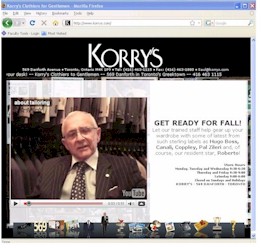 |
I like so many
things about Korry's, www.korrys.com
their website, and their famous owner / pitchman Saul Korman AKA the "Duke
of the Danforth”.
Saul has embraced the web completely and uses YouTube to "engage" the viewer and keep the viewer coming back since the videos correspond with his daily radio ads which are always changing and feature some interesting characteristic about this famous Danforth Gentlemen's clothier. It takes time and effort
to make these clips and then load them up to the site, and you have to
pay for the bandwidth and disc space .. but it really separates a business
from the run-o-the-mill sites and emphasizes that these vendors are very
eager for your business.
|

|
|
CONTACT I MAIN PAGE I NEWS GALLERY I E-BIZ SHORTCUTS I INT'L BIZ SHORTCUTS I MKTG&BUSINESS SHORTCUTS I TEACHING SCHEDULE |
| . | |
| MISTAKES I TEXTS USED I IMAGES I RANK I DISCLAIMER I STUDENT CONTRIBUTORS I FORMER STUDENTS I | |
| . |
Prof. W.
Tim G. Richardson © www.witiger.com ![]()